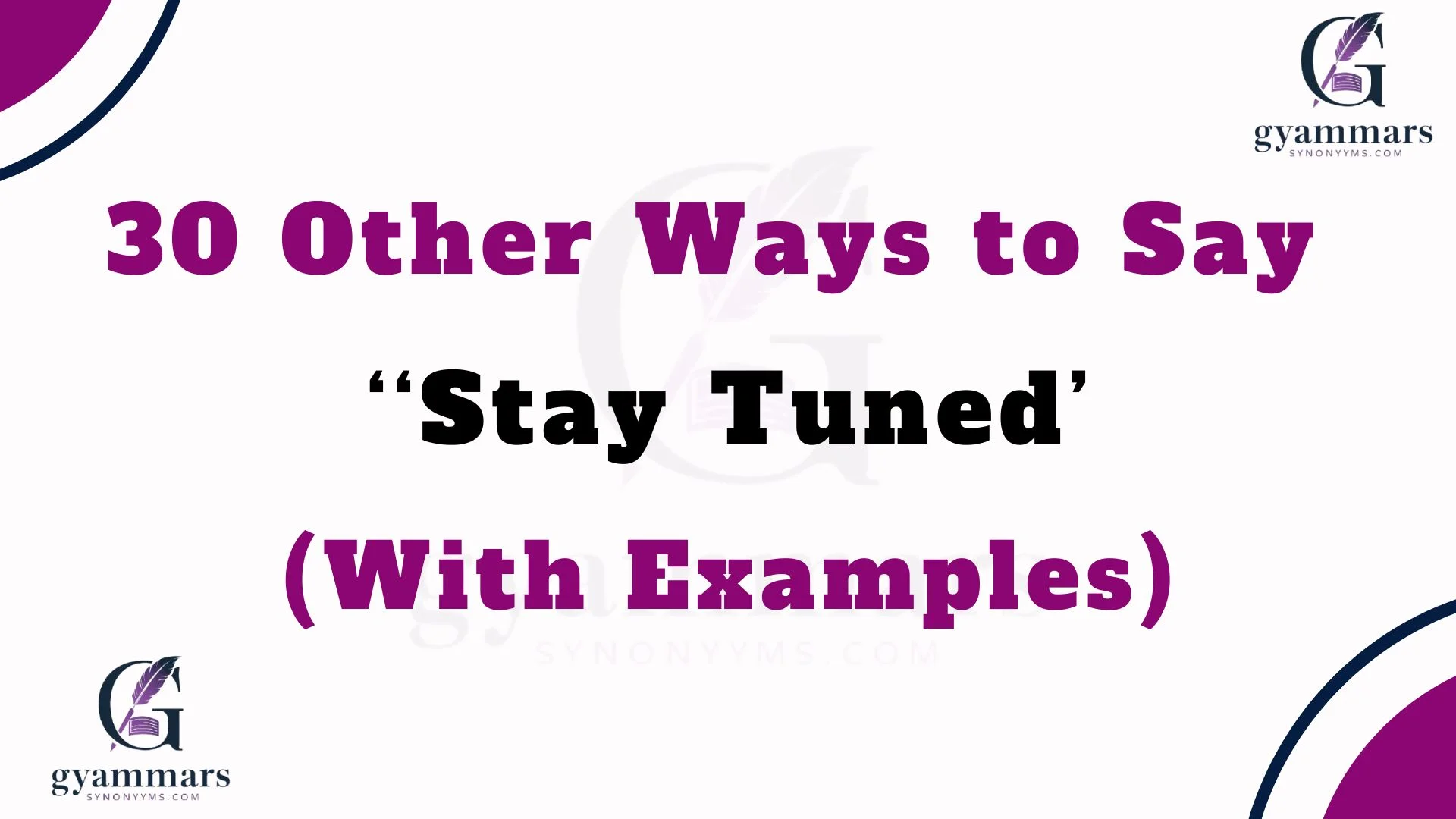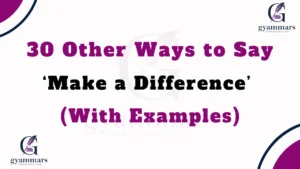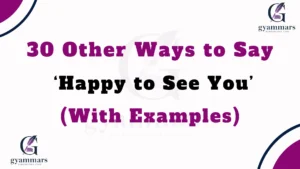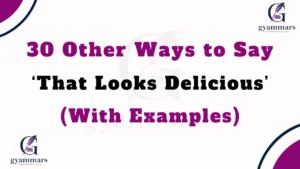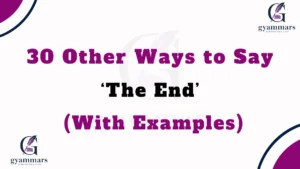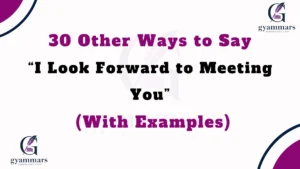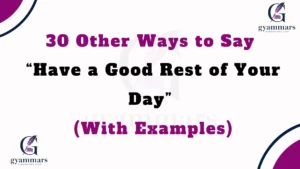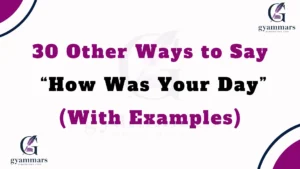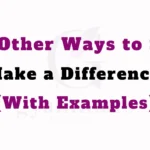Finding the right words can transform how your message is received. While “stay tuned” is a common phrase, sometimes it can feel too generic, formal, or impersonal. Using thoughtful alternatives can make your communication feel warmer, more engaging, and more meaningful—whether you’re addressing colleagues, customers, or friends. Below, you’ll find 30 other ways to say “stay tuned,” with explanations and examples to help you choose the best fit for your situation.
What Does “Stay Tuned” Mean?
The phrase “stay tuned” originated from radio and television broadcasting, where audiences were asked to keep their radios or TVs set to the same station for upcoming content. In modern use, it means “keep paying attention, more information is coming soon.”
Is It Professional/Polite to Say “Stay Tuned”?
Yes, “stay tuned” is professional and polite, but it can sometimes sound too casual or generic, depending on the setting. For more personalized or formal communication, choosing an alternative may create stronger connection and clarity.
Pros and Cons of Using “Stay Tuned”
Pros:
- Simple and widely understood
- Works in both casual and professional settings
- Creates curiosity and anticipation
Cons:
- Can sound repetitive if overused
- May feel too vague or impersonal
- Lacks warmth compared to alternatives
Synonyms For‘Stay Tuned’
- More Updates Coming Soon
- Keep an Eye Out
- Watch This Space
- More to Come
- Don’t Go Anywhere
- Stay Connected
- Look Out for Updates
- Coming Soon
- Hold Tight
- Stay with Us
- We’ll Keep You Posted
- Updates on the Way
- Stay Updated
- Don’t Miss Out
- News Just Around the Corner
- Await the Next Chapter
- More Surprises Ahead
- Stay Informed
- Something Exciting is Brewing
- Stick Around
- The Best is Yet to Come
- Keep Following Along
- Stay Alert
- Exciting Things Ahead
- Stay in the Loop
- New Details Coming Soon
- Be Ready
- Just Getting Started
- Anticipate What’s Next
- Stay Close
1. More Updates Coming Soon
Definition: Suggests that additional information will be shared shortly.
Explanation: Clear and straightforward, works in both casual and formal contexts.
Example: “Thank you for your patience—more updates coming soon!”
Best Use: Professional announcements, company updates.
Tone: Informative, direct.
Additional Notes: Great for audiences who prefer clarity over creativity.
2. Keep an Eye Out
Definition: Encourages someone to stay alert for future information.
Explanation: Slightly informal but engaging.
Example: “Keep an eye out for our next product reveal this Friday!”
Best Use: Marketing, promotions, casual workplace updates.
Tone: Friendly, upbeat.
Additional Notes: Works well when building anticipation.
3. Watch This Space
Definition: Invites people to keep following for upcoming news.
Explanation: Common in written announcements, especially online.
Example: “We’re working on something exciting—watch this space!”
Best Use: Social media, email updates.
Tone: Casual, anticipatory.
Additional Notes: Adds a touch of excitement.
4. More to Come
Definition: Signals that additional content will follow.
Explanation: Simple, versatile, and easy to understand.
Example: “We’ve just shared part one of our guide—more to come!”
Best Use: Educational or step-by-step content.
Tone: Neutral, encouraging.
Additional Notes: Great for projects with multiple stages.
5. Don’t Go Anywhere
Definition: Encourages people to stay engaged and not leave.
Explanation: Informal, playful, often used in live events or broadcasts.
Example: “Don’t go anywhere—we’ll be back after a short break.”
Best Use: Live streams, events, entertainment.
Tone: Fun, conversational.
Additional Notes: Too casual for corporate settings.
6. Stay Connected
Definition: Encourages ongoing engagement and communication.
Explanation: Emphasizes relationship-building.
Example: “Stay connected for future updates and opportunities.”
Best Use: Professional networks, newsletters.
Tone: Warm, professional.
Additional Notes: Works especially well for brand messaging.
7. Look Out for Updates
Definition: Reminds people that news will arrive soon.
Explanation: Clear and practical.
Example: “Look out for updates in your inbox this week!”
Best Use: Email communication, customer updates.
Tone: Neutral, professional.
Additional Notes: Good for logistics-heavy updates.
8. Coming Soon
Definition: Suggests that something is about to be revealed.
Explanation: Builds anticipation with a short phrase.
Example: “A brand-new feature is coming soon!”
Best Use: Product launches, teasers.
Tone: Exciting, promotional.
Additional Notes: Widely used in marketing.
9. Hold Tight
Definition: Encourages patience while waiting.
Explanation: Informal and supportive.
Example: “Hold tight—we’re finalizing the details now.”
Best Use: Casual team updates, customer service.
Tone: Reassuring, friendly.
Additional Notes: Not suitable for very formal contexts.
10. Stay with Us
Definition: Invites people to continue engaging.
Explanation: Suggests a sense of inclusion.
Example: “Stay with us—we’ve got something special coming up!”
Best Use: Events, live streams, announcements.
Tone: Warm, engaging.
Additional Notes: Great for fostering community spirit.
11. We’ll Keep You Posted
Definition: A promise to provide updates when available.
Explanation: Often used in business communication to assure someone they won’t miss important details.
Example: “We’ll keep you posted as soon as the new schedule is finalized.”
Best Use: Workplace updates, project management.
Tone: Professional, reassuring.
Additional Notes: Widely understood and trusted.
Also Read This : 30 Other Ways to Say ‘Great Asset to The Team’ (With Examples)
12. Updates on the Way
Definition: Indicates that new information is being prepared.
Explanation: Suggests something is already in progress.
Example: “Thanks for your patience—updates on the way.”
Best Use: Customer service, progress tracking.
Tone: Neutral, informative.
Additional Notes: Adds a touch of immediacy.
13. Stay Updated
Definition: Encourages someone to keep track of ongoing information.
Explanation: Often tied to newsletters, alerts, or notifications.
Example: “Subscribe to stay updated on our latest events.”
Best Use: Marketing, email lists.
Tone: Polished, professional.
Additional Notes: Works well in digital platforms.
14. Don’t Miss Out
Definition: Suggests urgency to stay engaged.
Explanation: Creates FOMO (fear of missing out).
Example: “Don’t miss out on our biggest sale of the year!”
Best Use: Advertising, promotions.
Tone: Energetic, persuasive.
Additional Notes: Effective for driving action.
15. News Just Around the Corner
Definition: Suggests something exciting will be revealed soon.
Explanation: Adds curiosity and anticipation.
Example: “Big news is just around the corner—stay excited!”
Best Use: Teasers, company news.
Tone: Optimistic, exciting.
Additional Notes: Great for building suspense.
16. Await the Next Chapter
Definition: Invites people to anticipate continuation.
Explanation: Works well with ongoing stories or projects.
Example: “This is only the beginning—await the next chapter!”
Best Use: Storytelling, creative industries.
Tone: Inspirational, thoughtful.
Additional Notes: Best when used metaphorically.
17. More Surprises Ahead
Definition: Promises unexpected and positive updates.
Explanation: Builds anticipation and joy.
Example: “We’ve revealed one feature, but there are more surprises ahead.”
Best Use: Product launches, entertainment.
Tone: Playful, exciting.
Additional Notes: Best when surprises are actually valuable.
18. Stay Informed
Definition: Encourages keeping up with reliable updates.
Explanation: Professional and clear.
Example: “Follow our newsletter to stay informed about industry news.”
Best Use: Newsletters, formal announcements.
Tone: Serious, professional.
Additional Notes: Good for official organizations.
19. Something Exciting is Brewing
Definition: Suggests something interesting is in development.
Explanation: Casual and creative phrasing.
Example: “Something exciting is brewing—stay tuned for the reveal.”
Best Use: Creative projects, event promotions.
Tone: Warm, playful.
Additional Notes: Works well with younger audiences.
20. Stick Around
Definition: Encourages people not to leave.
Explanation: Informal but inviting.
Example: “Stick around—we’ve got more fun planned.”
Best Use: Events, casual team chats.
Tone: Friendly, casual.
Additional Notes: Not suitable for formal writing.
21. The Best is Yet to Come
Definition: Suggests that greater things are in the future.
Explanation: Uplifting and motivational.
Example: “We’ve achieved a lot, but the best is yet to come.”
Best Use: Speeches, inspirational talks.
Tone: Hopeful, positive.
Additional Notes: Great for encouraging morale.
22. Keep Following Along
Definition: Encourages ongoing engagement.
Explanation: Suggests the journey is still happening.
Example: “Keep following along as we share behind-the-scenes updates.”
Best Use: Social media, blogs.
Tone: Casual, welcoming.
Additional Notes: Builds connection with long-term audiences.
23. Stay Alert
Definition: Suggests readiness for updates.
Explanation: Stronger than “stay tuned,” with a sense of urgency.
Example: “Stay alert—important news will be shared today.”
Best Use: Safety updates, urgent announcements.
Tone: Serious, urgent.
Additional Notes: Works best in official contexts.
24. Exciting Things Ahead
Definition: Promises positivity in the near future.
Explanation: Creates motivation and energy.
Example: “Thank you for your support—exciting things ahead!”
Best Use: Company updates, team motivation.
Tone: Encouraging, optimistic.
Additional Notes: Uplifting for group morale.
25. Stay in the Loop
Definition: Encourages ongoing awareness and participation.
Explanation: Suggests inclusion in important updates.
Example: “Join our newsletter to stay in the loop.”
Best Use: Internal communication, marketing.
Tone: Friendly, conversational.
Additional Notes: Great for community building.
26. New Details Coming Soon
Definition: Indicates specific upcoming information.
Explanation: Practical and professional.
Example: “New details coming soon about our next event.”
Best Use: Announcements, professional updates.
Tone: Neutral, clear.
Additional Notes: Works when timing matters.
27. Be Ready
Definition: Encourages preparation for something ahead.
Explanation: Adds excitement and urgency.
Example: “Be ready—our next surprise drops at midnight.”
Best Use: Marketing, event launches.
Tone: Energetic, urgent.
Additional Notes: Creates momentum.
28. Just Getting Started
Definition: Suggests much more is coming after the beginning.
Explanation: Inspires curiosity and commitment.
Example: “This is only part one—we’re just getting started.”
Best Use: Projects, speeches, storytelling.
Tone: Motivational, engaging.
Additional Notes: Works well to show growth.
29. Anticipate What’s Next
Definition: Invites curiosity for upcoming developments.
Explanation: Builds suspense intentionally.
Example: “Anticipate what’s next—it’s going to be big!”
Best Use: Creative marketing, announcements.
Tone: Suspenseful, confident.
Additional Notes: Works best in promotional tone.
30. Stay Close
Definition: Suggests keeping engaged and near.
Explanation: Warm and relational rather than formal.
Example: “Stay close—we’ll be sharing exciting updates soon.”
Best Use: Personal messages, community-driven brands.
Tone: Warm, intimate.
Additional Notes: Best for personal and community settings.
Conclusion
Words matter. By replacing “stay tuned” with more personal, engaging, and meaningful phrases, you can connect with your audience in ways that inspire, reassure, or excite them. Whether you want to sound professional (“stay informed”), playful (“don’t go anywhere”), or uplifting (“the best is yet to come”), you now have 30 strong alternatives to choose from.

“Mia Rose at Grammar Synonyms is your ultimate guide to mastering language with style and precision. Whether you’re looking to enhance your vocabulary, perfect your grammar, or discover the ideal synonym, Mia Rose offers expert resources and creative solutions to help you express yourself flawlessly. With Grammar Synonyms, unlock a world of language possibilities and elevate every piece of writing you create.
